I have been asked by a friend to turn a burial urn for her mother's ashes. My question is: what kind of closure is used for the lid?
-
December 2025 Turning Challenge: Single Tree! (click here for details) -
Congratulations to Bob Henrickson, People's Choice in the November 2025 Turning Challenge (click here for details) -
Congratulations to Steven Gordon for "Dropped Ice Cream Cone" being selected as Turning of the Week for December 8, 2025 (click here for details) -
Welcome new registering member. Your username must be your real First and Last name (for example: John Doe). "Screen names" and "handles" are not allowed and your registration will be deleted if you don't use your real name. Also, do not use all caps nor all lower case.
You are using an out of date browser. It may not display this or other websites correctly.
You should upgrade or use an alternative browser.
You should upgrade or use an alternative browser.
Burial Urn Question
- Thread starter Dennis J Gooding
- Start date
Haven't turned an urn yet (been thinking about it though). I've seen several different methods with screw threads (cut them, use pvc pipe threads, brass plumbing threads, etc). With that said, as I think about it my intent is not to have something that is re-opened so I'm thinking about just cutting mating surfaces with a recess to fill with silicone caulk; easy to do, and plenty secure for burial or a columbarium. My two cents, but haven't executed on it yet.
Tom Gall
TOTW Team
Depends. Most people use some form of threaded lid.I have been asked by a friend to turn a burial urn for her mother's ashes. My question is: what kind of closure is used for the lid?
Since it is for a friend can you get access to the ashes?..... If you don't mind handling the cremains.
I've made three smaller (keepsake ???) urns for family members. I turned the open vessels in two sections with a tenon (like a big box). The urns still had the mounting tenons for my chuck. Inserted the ashes (plastic bag) - aligned the grain - epoxied together. When epoxy was cured I touched up the turning (glue line) - final sanded and then used various methods to hide the glue lines.
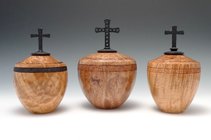
- Joined
- Feb 28, 2021
- Messages
- 1,770
- Likes
- 1,582
- Location
- Roulette, PA
- Website
- www.reallyruralwoodworks.com
if it is intended for burial, then you would have to check with the cemetary where the remains are to be interred, other than that I don't believe there are any regulations as to closures if the urn is intended to be kept (such as on the mantel or something)
No, it is not intended for actual burial.if it is intended for burial, then you would have to check with the cemetary where the remains are to be interred, other than that I don't believe there are any regulations as to closures if the urn is intended to be kept (such as on the mantel or something)
I ask the requestor. Some want access to spread ashes, others do not. Much simpler to glue/epoxy the lid/top on. A slip in/glue on lid may be ok with them even though they want access.
A threaded lid. It can be a plumbing fitting either plastic or brass that is glued in. Their was a guy that sold threaded wood inserts made for wood turners. Don't know if he is still around.
I make segmented urns and chase the threads. It's an easy process with segmented as no end grain. Cherry wood works well.
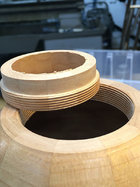
I make segmented urns and chase the threads. It's an easy process with segmented as no end grain. Cherry wood works well.

I have been making them since the mid 1990's and they have all been machine cut threads directly into the wood. The threads often need to be reinforced with CA so I will cut a partial thread then apply the CA before the final cut to size. The threaded lid can be sealed if desired by simply putting some glue on the threads. The picture below shows a similar Urn to my avatar:
-
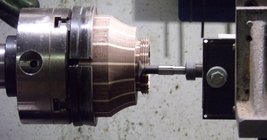 Cutting the male thread on the lid (The scroll chuck is mounted on my metal lathe and the router is mounted on the cross slide).
Cutting the male thread on the lid (The scroll chuck is mounted on my metal lathe and the router is mounted on the cross slide). -
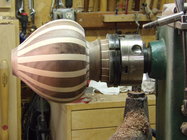 The lid back on the wood lathe and being used like a jam chuck to finish the bottom of the Urn
The lid back on the wood lathe and being used like a jam chuck to finish the bottom of the Urn 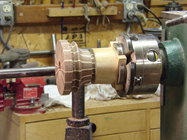 The lid held by a female threaded jam chuck for finish turning ( The jam chuck can also be mounted on a rotator or spray finishing).
The lid held by a female threaded jam chuck for finish turning ( The jam chuck can also be mounted on a rotator or spray finishing).
I use black ABS plumbing fittings. I really don't expect the people to open and peek inside the urn to see the ashes. It's a little unnerving to me to see some bone pieces in the ash. The idea of cremation is great, but the idea of Grandma's bones getting put into a grinder is a different story. Some mortuaries put in a plastic bag inside the urn first and then fill and add a twist tie to the bag so no ashes ever get out. For that, a thin bead of tacky wax would seal the container quite well. There has to be a ton of discussion on here before. I know some use brass shower drain parts as that has come up quite often. Edit; I just checked, there are 10 pages of posts and replies to your question.
Check out 'Fromwalnuttoantlers'website
You can also cut threads into rings of Corian or other similar polymer composites, these materials are more stable and less prone
to expansion and contraction as with wood when the humidity changes. Glue the polymer composite rings into the vessel and lid
and thread as you normally do on a turned box and lid. I use an E6000 adhesive to glue the rings into the box and lid which stays
pliable and provides a cushion between the wood and polymer ring. The wood can expand and contract and the rings do not deform
from the wood movement.
to expansion and contraction as with wood when the humidity changes. Glue the polymer composite rings into the vessel and lid
and thread as you normally do on a turned box and lid. I use an E6000 adhesive to glue the rings into the box and lid which stays
pliable and provides a cushion between the wood and polymer ring. The wood can expand and contract and the rings do not deform
from the wood movement.
This is the best solution to the problem of wood movement if both the vessel and the lid are similarly segmented, not only is it easy to get a clean thread either hand chasing or machine cut but the wood movement should be complimentary.A threaded lid. It can be a plumbing fitting either plastic or brass that is glued in. Their was a guy that sold threaded wood inserts made for wood turners. Don't know if he is still around.
I make segmented urns and chase the threads. It's an easy process with segmented as no end grain. Cherry wood works well.
View attachment 44011
The solution for solid wood is:
- Make the vessel out of the full round such that the annual rings are complete in the piece with the pith is in the (small) base and the movement will more likely be concentric or complimentary.
- The thread pitch should be coarse about 10TPI or 2.5MM to allow a loose fit that will have less tendency to bind when humidity changes.
- The problem with end grain crumble can be solved with CA at least with machine cut threads I can't say if it would work with hand chasing.
- I don't do inserts like metal or plastic because they are not compatible with wood and the only time I would use a wood insert is to be able to match the grain between the lid and the vessel.
We use 3D pritnted ABS fitings resized as needed - you can order them or if you have pantience print by yourself ( it takes a bit of time to figure out what precision you can get away with ) - we use to use brass than aluminium once - work rely well too and look way better but for what they are used for that level of quality is not needed it needs to not break apart and be able to be screved and unscrewed heandfull of times and from our testing 3D printed ABS it way more than enough probably gonna test in future PTG as alternative cuz it has nice shine to it but its gonna be less durable
Bronze threaded inserts are available from Niles Bottle Stoppers.
I just use black ABS pipe fittings recessed into the lid and top of the urn also.
The three I have made I was asked to seal them, so I obtained the cremains and glued them shut.
I provided a padded canvas bag, and suggested they keep a copy of the death certificate with the urn if traveling by air (TSA!).
I recently acquired a set of thread chasers, and thought I'd try that out on the next urn.
I provided a padded canvas bag, and suggested they keep a copy of the death certificate with the urn if traveling by air (TSA!).
I recently acquired a set of thread chasers, and thought I'd try that out on the next urn.
The only time I came near to possibly making an urn the whole family consulted on the project. Nobody in the immediate family had any experience with urns. Plus, nobody wanted the ashes or knew what to do with an urn full of ashes.
The solution did involve some woodworking. We built a large catapult to shoot pumeloes filled with ashes down a ten acre slope we had in the hills south of Santa Cruz. It was a fun party event for everybody and we all agreed the deceased would truly have approved.
The solution did involve some woodworking. We built a large catapult to shoot pumeloes filled with ashes down a ten acre slope we had in the hills south of Santa Cruz. It was a fun party event for everybody and we all agreed the deceased would truly have approved.
Spria craft sells brass threaded inserts, about 25 a pop depending on size.
 spiracraft.com
spiracraft.com
Project Kits
 spiracraft.com
spiracraft.com
